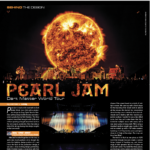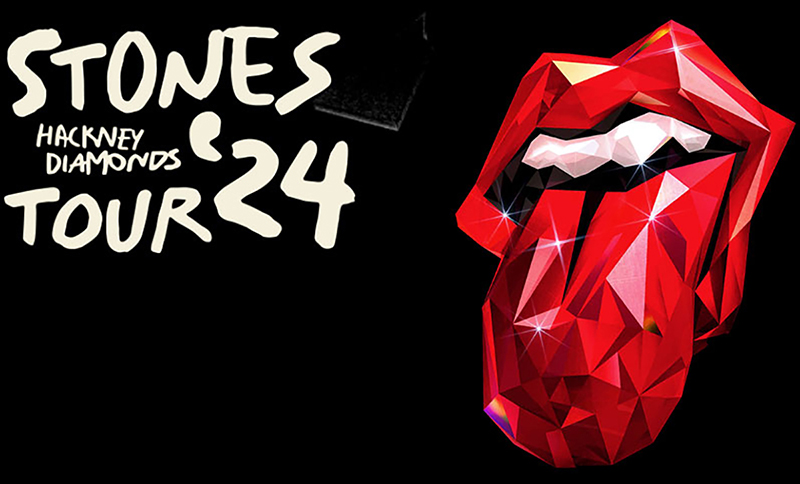
The Rolling Stones are back with their Hackney Diamonds Tour in North America. The tour was designed by the longtime team of Patrick Woodroffe and Terry Cook from Woodroffe Bassett along with Ray Winkler of STUFISH Entertainment Architects, Associate Lighting Designer/Lighting Director Ethan Weber, and Video Designer, Roland Greil. The lighting equipment and crew are from Upstaging and the video gear and crew were supplied by Nighthawk Video. Woodroffe, Cook, and Weber spoke with PLSN, and here in their own words, they give us a look behind the design of this dynamic tour that’s performing in 16 cities across the U.S. and Canada.
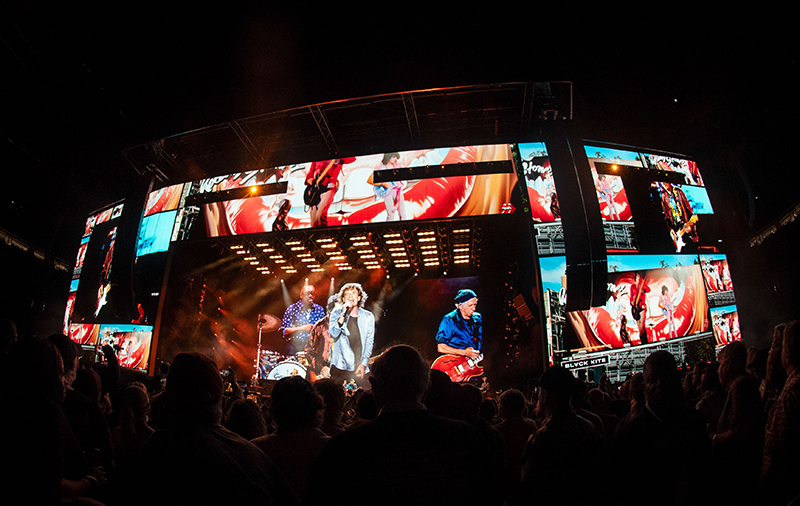
Patrick Woodroffe, Creative Designer
My role, as it’s been for many years, is Creative Director with an overview of the big picture—set, lighting, costumes, set list, all that stuff. I very much leave the detail to Terry as the Lighting Designer, but I would say we both wanted a contemporary feel for the show. Ray Winkler’s set design is very contemporary. It’s great. The Stones have always been a band of their time. In their early 80s now—which seems extraordinary—they still take it very seriously. They spend a lot of time planning and rehearsing. They’ll never work if they think they’re not going to be as good as they’ve ever been. They did a good month’s rehearsal, and they still had their chops.
This is not a greatest hits tour to make a few quid. This is what they do. They make a record, and they tour it. The brief to Ray was that we wanted something that was cool, modern, and sophisticated. That had some elegance to it, but also was able to reflect the raw quality of the Rolling Stones and the excitement that they engender. We had a challenge. Unlike a lot of the shows we used to do with Mark Fisher, those huge productions where we were able to amortize our show over 160 dates. We didn’t have that luxury, knowing that we were only going to be doing a small number of shows. We wouldn’t be designing and building our own stage from scratch, so we used a standard stage, and found a way to disguise that as much as possible. The idea of doing the whole thing with video seemed to make a lot of sense. It allows us therefore to paint a different picture for every song and have its own feel. STUFISH designed us a piece of architecture.
We got video content from Sam Pattinson and his Producer, Sam Brickman of Treatment Studios in London, some of which makes it look like a building. That’s an exciting picture—either a very contemporary, cool building or make it look like a beautiful old New York brownstone. Then Terry and I started looking at the lighting. We didn’t want to have a row of trusses, so we made the whole thing appear to be a hyper-symmetrical grid of lights, big round faces of lights, with heavy side light. Terry went off and created this beautiful design, co-designed by our Associate Lighting Designer, Ethan Weber, who’s been with the band for a long time. He programmed the show and runs the show on the road.
Roland Grail, our Screens Director, takes Treatment’s video content and stitches that together to tie in perfectly with what Ethan is doing. Mike Duque, our Video Director, cuts the show beautifully. He does this amazing double cut, and sometimes triple cut where he’s sending three signals out to three different parts of the screen.
The band is in a very good place now. They’re still a professional rock band, that’s a delight in working with them. For me, it’s with a huge sense of pride that I sit out front and watch the houselights go out for the first time on a show and see it develop in front of me.
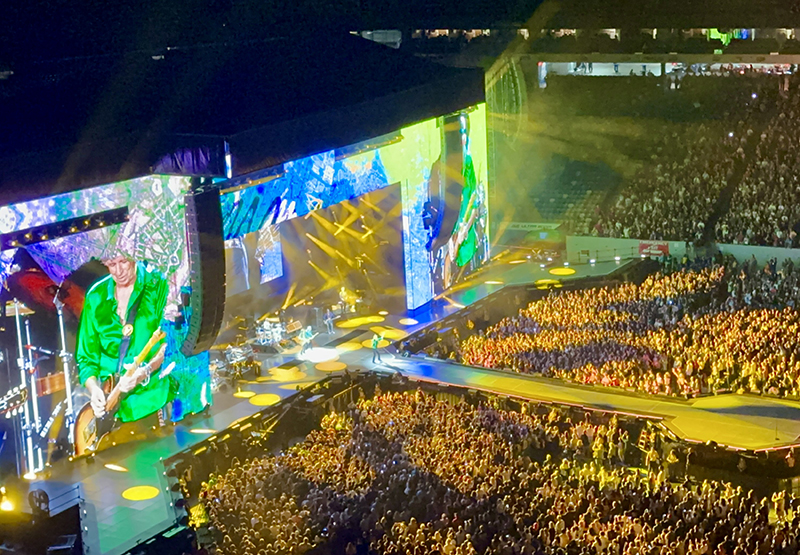
Terry Cook, Lighting Designer
Having such massive video, we had to work to make the lighting standout. Patrick and I communicated very early on, and had an idea of what we wanted to do, and Patrick’s creative journey. With lighting, we had limitations on truck space, budget, available space in the roof, and the large portion of video screen—the dominant light source. We put high slots in the video screen to be able to light the audience because the band seeing the audience is massively important to Mick, Keith, and Ronnie. Upstaging worked closely with Nighthawk Video to make that happen. They made it easy, quick, and safe for the crew to install and remove.
Overhead, we used light battens to give us a different, fresh look. We chose to go with a horizontal, stage left to stage right scenario. To cut through the video, we used both light battens and moving profiles. The workhorse of the overhead rig is the Elation Proteus Maximus, which is much brighter, and more modern than we’d used in the past. We also have ACME Super Dotlines as the moving batten light. Everything was equally spaced on the vertical and the horizontal planes so that everything aligned, and we had this beautiful grid. We had the Robe iFORTE LTX as our followspots, which is much brighter than what we’d used on the last tour. We need to film them, and fans need to see them. We used the Follow-Me system, which we’d used for the first time on the last Stones’ tour. It was very important that our artists didn’t have to wear tags. Also, Follow-Me allows us to add more lights than just the spots.
I’m very lucky that Ethan Weber is our Lighting Director and Associate Designer; he’s very much part of the process as I am, and he knows the Rolling Stones’ music inside and out. I knew what the video content was going to be, so I knew what color we were going to be in for our backdrop. Ethan and I will decide if we follow that color palette or reverse it. It’s a joint effort to create the looks. The Rolling Stones have a huge back catalog and change the set list every night. It’s an incredible accolade to Ethan who knows all the music to a pinpoint level. He works with me to make sure that song four feels as fresh as song 94. One of my favorites is “Give Me Shelter” where we start with a sunrise and there’s something quite beautiful about the video that takes the forefront, with the lighting following and having the sun rise from stage left to stage right. Lighting and video really play in harmony; they’re very much one source and should be seen as one entity.
Upstaging’s support—with John Huddleston and Dan Curley—has always been and will continue to be brilliant for us. Dan and I had several calls about how we would achieve the right products for the right job. That level of support, right from the start with Upstaging, was really good. They were committed to making sure the show looked and felt very clean. For the side torm ladders, they rebuilt them to a one-meter modular system all made of square form box truss instead of traditional round pipes. This meant all the lights would never shift or change form. It also meant we could get a bit more in the truck, saving on truck space, which is important to reduce our footprint from an environmental point of view, and cost-savings.
I’d like to thank the whole touring crew, but especially the video and lighting crew. It’s those men and women, who deliver the show nightly for the crowds, that are really important. They never get the thanks that they deserve because really, as a designer, you’re only as good as your crew.
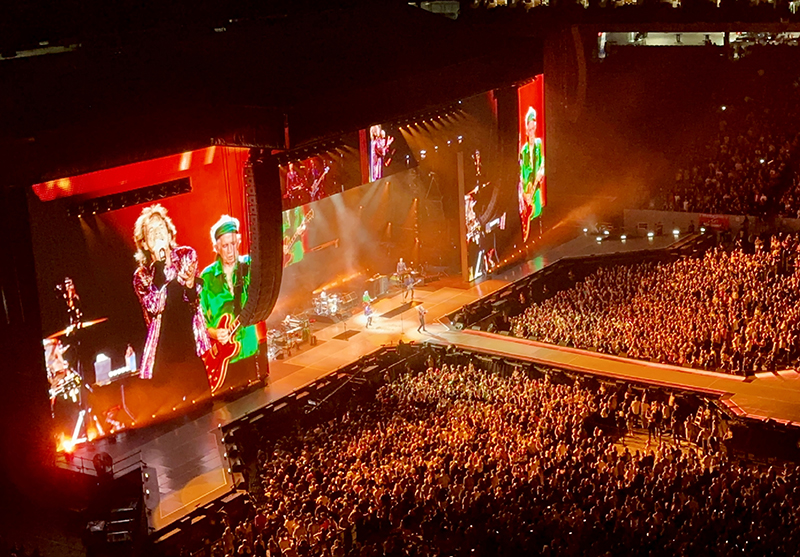
Ethan Weber, Associate Lighting Designer/Lighting Director
The lighting has been a progression for the last 30-some-odd years. Generally, we take the old songs, and the plot Patrick and Terry have come up with and rework all the old songs to fit that. We sometimes give the songs a new look. Maybe colors we’ve used for years don’t really fit. We looked at Treatment’s video content. A few years ago, I gave Treatment song by song colors we use for when they create content. Otherwise, we will change our colors to suit the new content. They have a new album this time, so there were nine more potential songs they were going to do. They have such a deep catalog and I’ve got close to 100 songs that I got through during my week with the rig in Houston during rehearsals. We have songs that will most definitely be on the set list, so we give those a little more time.
I always love the big white songs—“Start Me Up”, “Satisfaction”, “Jumpin’ Jack Flash.” All white, big sweeping movements. I always love doing “Paint it Black”, which is really stark. We turn off some of the upstage video to really let the lights play. It’s just a big, white statement, with a big blue take down in the middle. It’s one of the few times we change color on the spotlights and key lights to a deep blue. Otherwise, the mantra has always been that everybody on stage should be lit and the audience should be able to see everybody. We also light the audience more these days than in the past so the band can see them.
Upstaging’s support has been great. They always provide a great crew. We were able to bring a few key players over from past tours. Grant Hickey does our Follow-Me stuff, and he can fill in for Roland running video content if needed, or for me if I fall sick. We pulled Barry Brantford in from England; he’s been out with the tour since ’97. He’s been Mick’s spot operator for many years. I mean everybody’s important, but Mick runs around a bit more, and Barry knows his every move. Matt Helmick is our Lighting Crew Chief. He’s done a few tours and was promoted to Crew Chief on this one. He’s done a fine job. It’s nice having that consistency. The first Stones’ tour I did was Voodoo Lounge, and Opie was the Stage Manager with Jake Berry as the Production Manager. Opie has been the Production Director for years, and as challenging as it always is, you feel at home when you come out here. It’s so many familiar faces and Opie is obviously great at what he does. There are no stones left unturned on an Opie show; every detail is looked after. The Rolling Stones is the tour that we always look forward to; I’ll always make myself available for it. I’m always excited and I never take it for granted. Every show is exciting and still, after these many years, there are still shows that give me goosebumps as I’m running them. You watch Mick, Keith, Ronnie and there’s never a show that they phone in. They wouldn’t do it if they couldn’t do it 100%. They’re giving 100%, you never want to half ass it yourself.
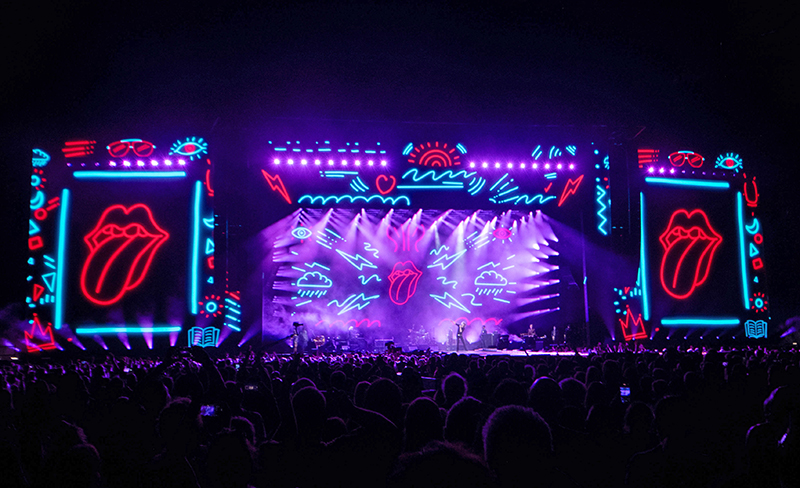
VENDOR VIEW
Upstaging: Dan Curley, Project Manager
On an Upstaging solution you would call out
The band, particularly Mick Jagger, covers a huge amount of real estate with the main stage, very wide wings, and a long thrust. Our Follow-Me Operator Grant Hickey and Upstaging Follow-Me Specialist John Weston came up with a brilliant operation set-up with two systems linked together for the operators to see all the stage surfaces and track a very mobile band. For FOH followspots, we’re using 24 Robe iFORTE LTX positioned on towers and using the Follow-Me system for remote tracking of the band.
On other interesting technical solutions
Just prior to shop prep, Mick Jagger requested that he wanted the footlights on the thrust to fade up on him when he is near them, and to fade out when he walks away from them. Designer Terry Cook specified Chauvet PXL Bar 16 to line the thrust. We were able to utilize a new feature in Follow-Me called “Proximity” that told the PXL Bars when they needed to bring up their intensity when Mick was tracked out on the thrust by the Follow-Me operator backstage using the target on his screen. It was amazingly easy to set up and it has worked flawlessly. Another interesting solution is, we collaborated with our friends at Nighthawk Video and worked together on a cool custom panel that fits in with the tiles at the top of the LED walls for a moving light to poke out. This also had double DWE blinders on either side of the mover. The custom panel stays inside a cluster of the LED tiles for travel on the carts. At load-in, once the cluster of tiles is hanging like a normal LED wall load-in, our crew comes along and releases a small arm that folds down for the moving light to attach to. It is secured with a latch and then the arm folds up, locking the fixture in a 90° position. It is some very sexy CNC work that came together nicely for fast touring.
On supporting the designers
Terry Cook is one of the most jovial designers I have had the pleasure to work with. He was receptive to new products that we thought would be amazing assets in a designer’s toolbox—one of those being the new ACME Super Dotline. Terry filled the open space above the stage with the Super Dotline. We only had one revision from the first design pass and then we were off and running. Then for pre-viz programming in Chicago, Terry and Patrick were flying in and out, taking shifts with Lighting Director Ethan Weber as they had other projects around the globe going on at the same time. We helped arrange a quiet place downtown with a compliment of the tour’s lighting fixtures before they moved to our facility for live programming with the full rig hanging in our rehearsal space.
On why Upstaging was the right vendor for this production
We like to pride ourselves on being able to take the design and figure out all the nuances to make as an effective package to load-in every day as possible. Having an in-house fabrication shop that can whip out any gadget or doodad that we need with little warning to make a fixture hang better or a cart to get it there safer is a big asset in bringing these designs to life.
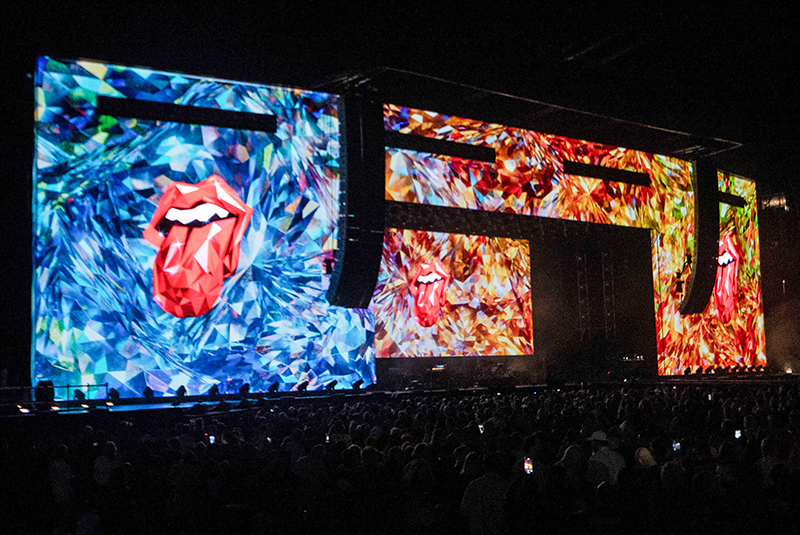
VENDOR VIEW
Nighthawk Video: Ben Rader, Director of Touring
On the technical solutions Nighthawk Video provided
Aside from the normal challenges of building a show of this size with that amount of LED, we were engaged to come up with a solution for the lighting window frames at the top of the screens. This required some design and fabrication to seamlessly integrate with our Saco touring frames, as well as giving lighting the ability to change out their moving light once at trim. We worked closely with Upstaging who wired the frames and installed ACLs into it. We worked with their touring lighting techs and some of our touring video crew to do a test fit at our shop of their moving lights hung in our LED wall setup as if on the road, letting them work out any quirks and be as ready for the first load in as possible. The solution we designed has really made that aspect seamless and far less cumbersome than it could have been. Another element which is always a challenge with screens of this size and with that many pixels, is working closely with the content design team to ensure smooth delivery of their content and being able from a signal flow, and LED processing standpoint, deliver that content as intended. Working with the team at Treatment Studios, our open dialogue throughout the pre-production process always puts us in the right spot once built to present the content and camera I-Mag as beautifully as planned.
On supporting the designers
It’s always our pleasure to work with the design teams of Patrick Woodroffe and WBD, and Ray Winkler and STUFISH. Production Director, Dale “Opie” Skjerseth gave Nighthawk Video free reign to be very involved with the design teams from the start. That early connection is totally necessary to achieve their vision with the gear and translate it to reality with the touring crew executing it. Roland Greil also plays the key role of being tasked to deliver the vision while keeping Nighthawk Video in the loop and ready to adapt to any forthcoming changes or challenges during the pre-production process. Once the show hit the road, our incredible touring crew could rely on Roland to execute the vision on the LED canvas they work so hard to build everyday. I think in return he completely trusts us to give him all the tools at 100% daily to execute his role. Roland’s integration and collaboration with Mike Duque, our Camera Director, gives everyone including the camera operators the creative freedom to really showcase this band utilizing all our individual talents.
On why Nighthawk Video was the right vendor
We pride ourselves in meeting every challenge presented to us. When The Rolling Stones go out it’s always big. We do “big” really well. Our touring crew and our shop are very experienced in dealing with shows of this scale. Our commitment to provide the best crew and the best gear really shines each night when this band becomes larger than life. It has been, and will always be, a huge honor for Nighthawk Video to be part of what The Rolling Stones do. To be able to work with the legends on stage, and the legends behind the scenes who produce this tour, is always a lot of fun for us.


